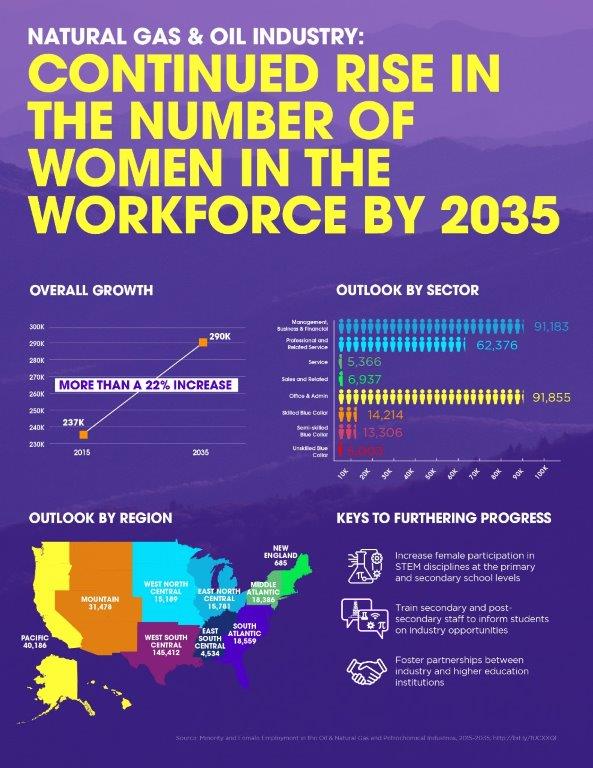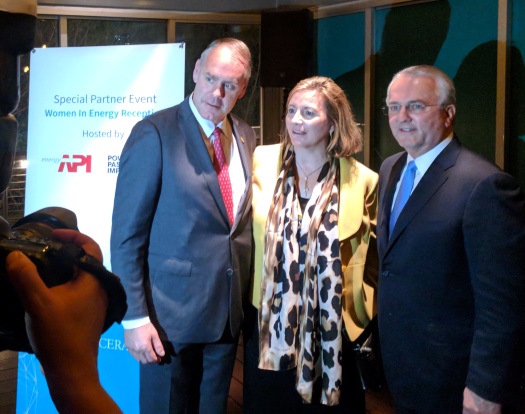The Women of Industry: Continuing Positive Momentum
Mark Green
Posted March 29, 2018
Women continue to advance in the natural gas and oil industry. Yes, there’s more progress to be made – and it will be made – yet, it’s clear the old narrative that our industry remains the realm of men is just so yesterday – yesteryear, really.
This week Royal Dutch Shell announced former Maersk Oil CEO Gretchen Watkins will become president of its North American operations. Last week, Susan Dio was named chairwoman and president of BP America. There are other recent examples, including Julie Robertson, president and CEO of Noble Corporation and Vicki Hollub, president and CEO of Occidental Petroleum.
The point is that women are capitalizing on opportunities in our industry – from the very top on down. Industry research projects that women will account for hundreds of thousands of the 1.9 million new job opportunities our companies are projected to create between now and 2035. The task is identifying and recruiting them.

Part of that job is making sure women know that today’s natural gas and oil industry is technologically advanced and forward looking. It’s not your daddy’s oil – and there are great energy careers out there to be had by women.
Creating more awareness on that point is a necessity. In a survey a couple years ago, a majority of women said they were willing to work in industry, yet a full quarter of those who had never applied for an industry job either said they didn’t know industry was hiring or simply had never thought about being in natural gas and oil.
Changing that reality is one reason API has hosted a “Women in Industry” reception at the annual CERAWeek energy conference for that last three years. At this year’s event we recognized one of the pioneers for women in natural gas and oil, Emma Cochrane of ExxonMobil, who leads the company’s liquefied natural gas business (pictured below with U.S. Interior Secretary Ryan Zinke, left, and API President and CEO Jack Gerard, right).

Cochrane, the company’s vice president of liquefied natural gas, talked about her career’s trajectory and those of other women in industry:
“This is a journey, we’re not done. We are making progress, things are improving, but we have a long road to travel to get to where we need to in terms of women in senior leadership roles in our industry and represented all the way through – not just the pipeline coming in, people that are being hired out of school, but engineering, geoscience and technology focused, but seeing progress all the way through until we have that same level of representation to the senior leadership level.”
Building an even more diverse industry workforce for the future hinges on education and also forging relationships. Cochrane said school-age girls must become interested in energy-related careers – careers that intersect with technology, business and geopolitics. And she said women in industry are helped by men in industry:
“It’s great to see so many here because you know what, men matter, and in this journey you have to be responsive and advocates for women and minorities coming through the system. And we can’t do this without the predominant group, which in most countries in which we work are white males. You’re part of the solution, and you have to step up and make a difference. So thank you for being with us today and showing that you recognize this is important.”
Cochrane said laying the foundation for a workforce that includes more women – by educating on unconscious bias, equalizing gender pay and meeting the needs of people with dual careers – is smart and strategically sound from a business standpoint:
“This isn’t a gender issue, this is a business issue. There is a ton of data that says that better business results are achieved with diverse work teams, diverse, inclusive work teams. … We change business outcomes with diverse and inclusive teams.”
Tracee Bentley, executive director of the Colorado Petroleum Council and a recent winner of PinkPetro’s GRIT award recognizing energy leaders (along with API’s Gerard and several others), recently posted on the way ahead for women in energy:
Getting to this place has required commitment from the industry, but more importantly, commitment from individuals within the industry, who are dedicated to personally paving a smooth path for women in natural gas and oil.
Stacey Olson, vice president of Chevron’s Appalachian Mountain Business Unit and recently recognized as one of the most influential women in energy by Oil and Gas Investor magazine, said women must seize the opportunity and be totally prepared for the energy careers they want. Olson talked about this in an article posted on Medium:
“I truly believe women can aspire to do anything and be successful in any role. … I learned that there are rewards for making bold choices in your career and stepping outside your comfort zone. … [L]earn about the business. I earned my MBA early in my career, and it has helped me tremendously. It’s important to be fluent in the fundamentals of running a business. I realize an MBA is not for everyone. You can take a class in finance or economics, or simply just take opportunities to ask questions and learn from other people where you work.”
Recognized as one of the most “Influential Women in #Energy,” Stacey Olson reflects on her career guideposts & mentors. @OilnGasInvestor #WomensHistoryMonthhttps://t.co/Ypt46mcK9D
— Chevron (@Chevron) March 15, 2018
Occidental’s Hollub is another pioneer for women in energy, rising to her current post in 2016. In the video below, Hollub describes Oxy’s vision for energy development in the Permian Basin and the company’s collaborative approach:
Again, as Cochrane described it, women in natural gas and oil are on a journey. There’s more road to travel, but the point is it’s being traveled by skilled professionals who are making important contributions to America’s energy present and future.
About The Author
Mark Green joined API after a career in newspaper journalism, including 16 years as national editorial writer for The Oklahoman in the paper’s Washington bureau. Previously, Mark was a reporter, copy editor and sports editor at an assortment of newspapers. He earned his journalism degree from the University of Oklahoma and master’s in journalism and public affairs from American University. He and his wife Pamela have two grown children and six grandchildren.


